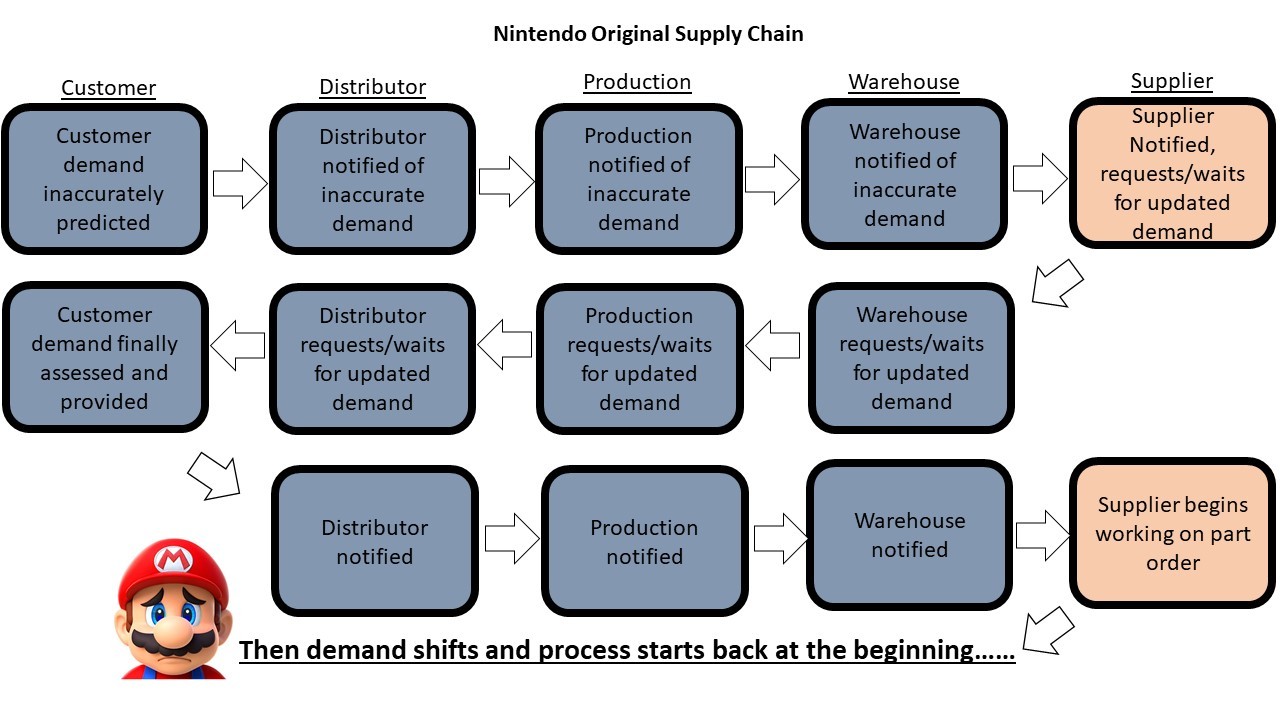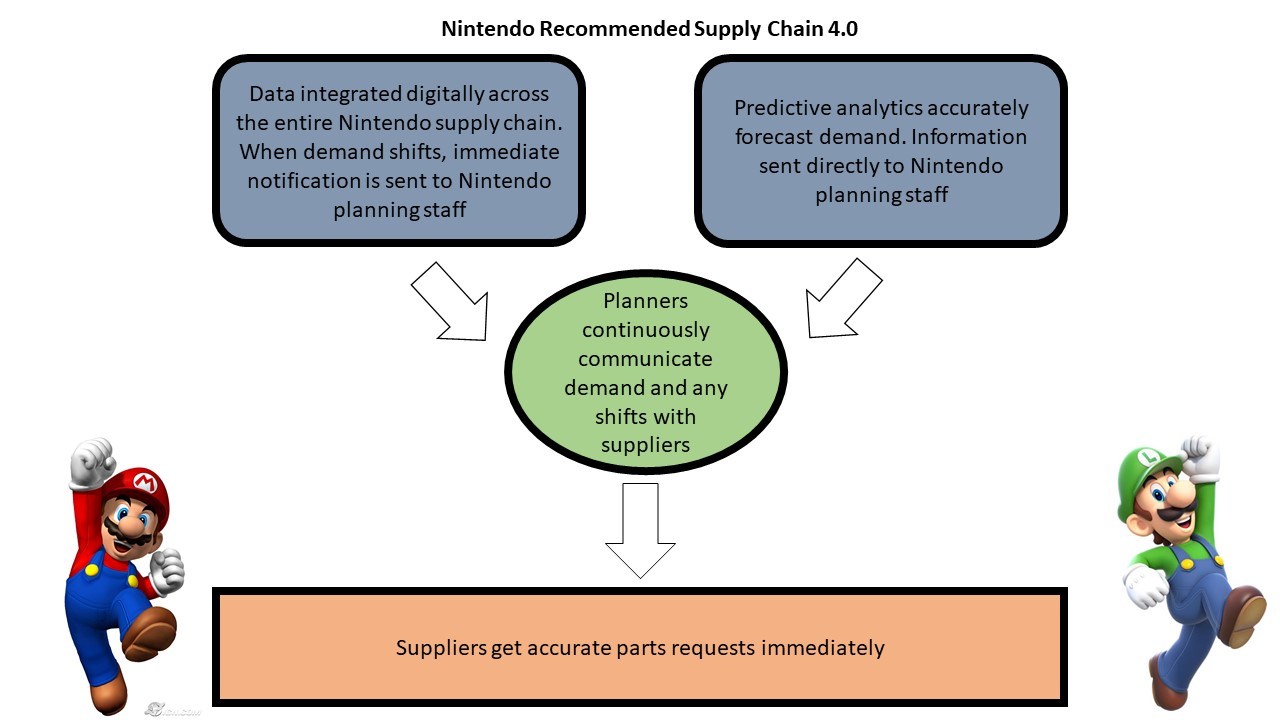Nintendo Switch Super Bowl Li Commercial - Extended Cut Download
On March iii, 2017, Nintendo released Switch, an innovative video game system that provided both mobile and living-room gaming access [1].
Video: Nintendo Switch [2]
Just weeks after the release, Switch was out of stock at nearly retailers [3]. Nintendo cited the shortages were due to multiple bug with their supply chain ecosystem [4]. Can Nintendo rebound and address these critical problems before their next product release?
No Digitalization = No Mario For You
A supply shortage is non a new concept for Nintendo. In 2016, Nintendo released the NES Classic Mini, which was an instant gem in the gaming customs. However, Nintendo failed to forecast properly, resulting in massive supply shortages, and forced the production to be discontinued in 2017 [5].

Fast forward just a few months later, and Nintendo found themselves in the same exact position with the release of Nintendo Switch. On the horizon, in the Fall of 2017, another Nintendo release has been scheduled, the SNES Archetype, which analysts predict will suffer the same fate every bit the NES Classic Mini and the Switch [seven].

Nintendo'due south issues stem from their inaccurate forecasts of demand and their inability to track supply and demand signals across their network. This translates to poor turnaround from their parts' manufacturers [nine]. If Nintendo tin't digitalize their supply concatenation, then the company will never take a successful launch of a product. As evident by the NES Classic Mini, Switch, and SNES Classic releases, these inefficiencies result in reduced sales and low customer satisfaction.
Root Concerns and Nintendo's Response
One of the key problems stems from multiple bottleneck chokepoints with their suppliers. Alps Electrical, which provides components for Switch controllers, is struggling to respond to the immediate and surprising requests from Nintendo for parts [ten].
Nintendo is likewise directly competing against other companies, such as Apple, for the same manufactured parts. Toshiba, for example, provides flash memory to many industry-wide competitors. The contest can offer better terms to the manufacturers since their orders are of college book than Nintendo's. This, coupled with Nintendo's lack of transparency on orders, results in inefficient turnaround from suppliers [eleven].
Additionally, Nintendo struggles to empathize the demand for their products. After the launch of Switch, Reggie Fils-Aimé, president of Nintendo of America, said:

"But what I don't know is what the demand is going to exist. And in that location is a potential that need is going to outstrip supply." [12]
These scary words stem from Nintendo using historical data to predict future demand. This is a slippery slope every bit they have had mixed historical performance over the years. For instance, in 2012, Nintendo launched the Wii U, which significantly nether performed. Relying on data from these types of launches will inevitably pb to incorrect demand predictions [14].
Nintendo's short and medium-term plans announced to exist the same: They are continuing to work on improving their data collection, forecasts of demand, and relationships with their suppliers. Yet, this has been their arroyo for years, with multiple flawed launches. What else can be done to accost these issues?
Recommended Path Ahead
Nintendo'due south short-term goal needs to immediately integrate data beyond the supply chain. It is evident by the same product releases that this is Not currently happening. Rather, each division is acting independently within their own silo, increasing the amount of time information technology takes for information to flow throughout the chain. With this digital supply chain, equally soon equally customer demand shifts, planners within Nintendo can appraise the impact and share it with their suppliers immediately to reduce component manufacturing bottlenecks [15]. Additionally, if Nintendo can make the advice seamless with their suppliers, it will promote a healthy human relationship that will perhaps give Nintendo a competitive edge over contest when trying to become parts.

Their medium-term goal should focus on their poor supply and demand predictions. Nintendo MUST prefer predictive analytics in demand planning. This strategy will permit the visitor to analyze thousands of demand-influencing variables, ranging from trends on social media networks to sensor information. The drove of this data may have time, hence a 2+ year deadline. With this information, Nintendo tin can model the complex relationships from the derived information and create an authentic demand program, reducing forecasting errors by 30 to 50 percent [sixteen].

As Nintendo ramps up for their 2018 launches for Game Boy and N64 Classic [xviii], they demand to embrace Supply Chain 4.0 by improving the visibility across their supply chain and using information analytics to better sympathize their demand. Without these changes, Nintendo is limiting the world's exposure to Mario, Zelda, and the rest of the gang.
Questions to Consider
*Is Nintendo strategically limiting their supply to increase demand, thereby creating more of a buzz around their product?
*Will increased transparency be enough to compete with Apple and other companies for premium access to suppliers?
Discussion Count: 796
[1] Needleman, Sarah, "Nintendo's switch hit: Game console is in short supply ahead of holidays," Dow Jones Institutional News, August 2017, http://search.proquest.com.ezp-prod1.hul.harvard.edu/docview/1932698613?accountid=11311, ABI/INFORM via ProQuest, accessed November 2017.
[2] YouTube, "Nintendo Switch Super Bowl LI Commercial-Extended Cutting," https://www.youtube.com/sentinel?5=CdWd8fUC71g, accessed November 2017.
[3] Needleman, "Nintendo'southward switch hitting: Game console is in brusque supply ahead of holidays"
[4] "Nintendo (NTDOY) Falters With Preorders for SNES Archetype," Zacks Investment Research, August 2017, http://search.proquest.com.ezp-prod1.hul.harvard.edu/docview/1931289630?accountid=11311, ABI/INFORM via ProQuest, accessed November 2017.
[5] Ibid.
[6] BGR, "NES Archetype Edition Back In Stock on Amazon for Five More than Cities," bgr.com/2016/12/xv/nes-classic-edition-amazon-more-cities/, accessed Nov 2017.
[7] "Nintendo (NTDOY) Falters With Preorders for SNES Classic"
[viii] YouTube, "SNES Classic Edition (aka Super NES Mini) Announced By Nintendo -Talk About Games," https://i.ytimg.com/half-dozen/NrzH4LAPO5E/maxresdefault.jpg, accessed November 2017.
[ix] Needleman, "Nintendo's switch hit: Game console is in short supply ahead of holidays"
[10] Bradshaw, Tim, "Component Bottlenecks Hit Nintendo's Switch," Fiscal Times, September 2017, https://www-ft-com.ezp-prod1.hul.harvard.edu/content/7bafad44-95cd-11e7-a652-cde3f882dd7b, via Financial Times, accessed November 2017.
[xi] Mochizuki, Takashi. "Nintendo Fights a Parts Shortage," Wall Street Periodical, May 2017, https://search-proquest-com.ezp-prod1.hul.harvard.edu/businesspremium/docview/1903693833/abstract/B9861BE051A34271PQ/1?accountid=11311, ABI/INFORM via ProQuest, accessed November 2017
[12] Bradshaw, "Component Bottlenecks Striking Nintendo's Switch"
[13] https://world wide web.dualshockers.com/wp-content/uploads/2016/06/Reggie2.jpg
[14] Lewis, Leo, "Switch success drives huge jump in Nintendo profits," Financial Times, October 2017, https://www-ft-com.ezp-prod1.hul.harvard.edu/content/04bac110-bd69-11e7-b8a3-38a6e068f464, via Fiscal Times, accessed November 2017.
[15] Schrauf, Stefan and Phillip Bertram. "Industry 4.0: How Digitalization Makes the Supply Chain More Efficient, Agile, and Customer-Focused," https://hbs.instructure.com/courses/3724/files/247334/download ?verifier=YDmBuPuFfQiqyNZsKti91mspjDiMTFLb8J3xztwC&wrap=1, accessed November 2017.
[16] McKinsey & Company, "Supply Chain 4.0 in Consumer Goods," https://world wide web.mckinsey.com/industries/consumer-packaged-goods/our-insights/supply-chain-4-0-in-consumer-appurtenances, accessed November 2017.
[17] Leahey, Mark. Unpublished document, Harvard University.
[18] Morris, Chris, "Nintendo Might Be Working on a Gameboy Classic Edition," Fortune.com, September 2017, http://web.a.ebscohost.com.ezp-prod1.hul.harvard.edu/ehost/item/detail?vid=2&sid=911def19-68d6-4767-9c07-c7a24fc1d052%40sessionmgr4006&bdata=JnNpdGU9ZWhvc3QtbGl2ZSZzY29wZT1zaXRl#AN=125605549&db=bth, Business Source Complete, EBSCO accessed Nov 2017.
DOWNLOAD HERE
Posted by: lemelinmorthattly.blogspot.com
Post a Comment